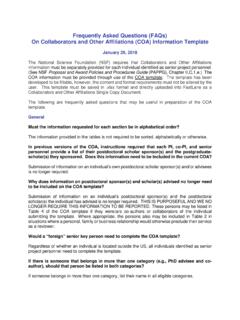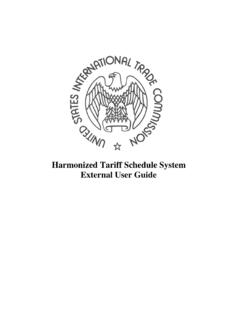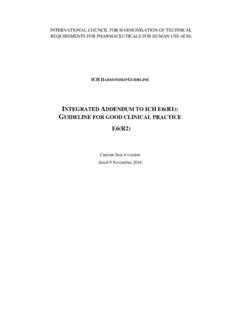Transcription of Definitions of Research and Development: An Annotated ...
1 1 Definitions of Research and development : An Annotated Compilation of Official Sources March 2018 Contents Introduction .. 1 I. OECD Frascati Manual .. 2 II. Business Enterprise R& 3 III. Federal and State Government R&D .. 9 IV. Higher Education R&D and R&D by Nonprofit Organizations .. 21 V. R&D in National Accounts and Globalization Manuals .. 24 References .. 25 Introduction This publication provides Definitions of Research and development from several and international sources. The first section (I) presents statistical Definitions of R&D from the Organisation for Economic Co-operation and development (OECD) Frascati Manual 2015: Guidelines for Collecting and reporting Data on Research and Experimental development . The next three sections are organized by sectors of the economy that perform or fund R&D businesses (II), the federal government and state governments (III), and academic and nonprofit organizations (IV).
2 Sources for Definitions of R&D include the Office of Management and Budget (OMB), federal procurement, tax and accounting guidance, and surveys from the National Center for Science and Engineering Statistics (NCSES), National Science Foundation (NSF). The last section (V) presents R&D Definitions from statistical manuals on National Accounts and globalization. R&D Definitions are provided unedited as they appear in their original sources. Unless otherwise noted in the body of the publication, the Definitions were downloaded in April and May 2017. For more information, contact: Francisco Moris National Center for Science and Engineering Statistics National Science Foundation 2415 Eisenhower Avenue, Suite W14200 Alexandria, VA 22314 703-292-4678 2 I. OECD Frascati Manual Description: The updated Frascati Manual (7th ed., OECD 2015) provides the definition of Research and experimental development (R&D) and of its components, basic Research , applied Research , and experimental development .
3 These Definitions are essentially unchanged from those in previous editions of the manual. Where there are differences, they reflect changes in culture and the use of language. To provide guidance on what is and what is not an R&D activity, five criteria are provided requiring the activity to be novel, creative, uncertain in its outcome, systematic, and transferable and/or reproducible. definition : Research and experimental development (R&D) comprise creative and systematic work undertaken in order to increase the stock of knowledge including knowledge of humankind, culture and society and to devise new applications of available knowledge. A set of common features identifies R&D activities, even if these are carried out by different performers. R&D activities may be aimed at achieving either specific or general objectives. R&D is always aimed at new findings, based on original concepts (and their interpretation) or hypotheses.
4 It is largely uncertain about its final outcome (or at least about the quantity of time and resources needed to achieve it), it is planned for and budgeted (even when carried out by individuals), and it is aimed at producing results that could be either freely transferred or traded in a marketplace. For an activity to be an R&D activity, it must satisfy five core criteria. The activity must be: novel creative uncertain systematic transferable and/or reproducible. All five criteria are to be met, at least in principle, every time an R&D activity is undertaken whether on a continuous or occasional basis. The definition of R&D just given is consistent with the definition of R&D used in the previous editions of the Frascati Manual and covers the same range of activities. The term R&D covers three types of activity: basic Research , applied Research and experimental development .
5 Basic Research is experimental or theoretical work undertaken primarily to acquire new knowledge of the underlying foundations of phenomena and observable facts, without any particular application or use in view. Applied Research is original investigation undertaken in order to acquire new knowledge. It is, however, directed primarily towards a specific, practical aim or objective. Experimental development is systematic work, drawing on knowledge gained from Research and practical experience and producing additional knowledge, which is directed to producing new products or processes or to improving existing products or processes. 3 Distribution by type of R&D A breakdown by type of R&D is recommended for use in all four of the sectors used in this manual [Business enterprise; Higher education; Government; and Private nonprofit].
6 There are three types of R&D: basic Research applied Research experimental development . Basic Research Basic Research is experimental or theoretical work undertaken primarily to acquire new knowledge of the underlying foundations of phenomena and observable facts, without any particular application or use in view. Applied Research Applied Research is original investigation undertaken in order to acquire new knowledge. It is, however, directed primarily towards a specific, practical aim or objective. Experimental development Experimental development is systematic work, drawing on knowledge gained from Research and practical experience and producing additional knowledge, which is directed to producing new products or processes or to improving existing products or processes. Source: OECD, Frascati Manual , Chapter 2. The full Frascati Manual and current and upcoming online Annexes are available at II.
7 Business Enterprise R&D A. Financial Accounting Standards Board Description: Financial Accounting Standards Board (FASB) Accounting Standards Codification (ASC) provides GAAP (generally accepted accounting principles) for businesses. ASC is organized by topics and Topic 730 is devoted to Research and development (formerly covered in FASB Statement No. 2 Accounting for Research and development Costs ). Material formerly covered in FASB Statement No. 68 Research and development Arrangements also appears under Topic 730. The FASB material below, copyrighted by the Financial Accounting Foundation, 401 Merritt 7, Norwalk, CT 06856, is used with permission. Definitions : Topic 730 Research and development , 730-10-20 Glossary Research is planned search or critical investigation aimed at discovery of new knowledge with the hope that such knowledge will be useful in developing a new product or service (hereinafter 4 product ) or a new process or technique (hereinafter process ) or in bringing about a significant improvement to an existing product or process.
8 development is the translation of Research findings or other knowledge into a plan or design for a new product or process or for a significant improvement to an existing product or process whether intended for sale or use. It includes the conceptual formulation, design, and testing of product alternatives, construction of prototypes, and operation of pilot plants. Topic 730 Research and development , 730-10-55 Implementation Guidance and Illustrations Examples of Activities Typically Included in Research and development 55-1. The following activities typically would be considered Research and development within the scope of this Topic (unless conducted for others under a contractual arrangement [See NOTES below]): a. Laboratory Research aimed at discovery of new knowledge b. Searching for applications of new Research findings or other knowledge c.
9 Conceptual formulation and design of possible product or process alternatives d. Testing in search for or evaluation of product or process alternatives e. Modification of the formulation or design of a product or process f. Design, construction, and testing of preproduction prototypes and models g. Design of tools, jigs, molds, and dies involving new technology h. Design, construction, and operation of a pilot plant that is not of a scale economically feasible to the entity for commercial production i. Engineering activity required to advance the design of a product to the point that it meets specific functional and economic requirements and is ready for manufacture j. Design and development of tools used to facilitate Research and development or components of a product or process that are undergoing Research and development activities.
10 Examples of Activities Typically Excluded from Research and development 55-2. The following activities typically would not be considered Research and development within the scope of this Topic: a. Engineering follow-through in an early phase of commercial production b. Quality control during commercial production including routine testing of products c. Trouble-shooting in connection with break-downs during commercial production 5 d. Routine, ongoing efforts to refine, enrich, or otherwise improve upon the qualities of an existing product e. Adaptation of an existing capability to a particular requirement or customer's need as part of a continuing commercial activity f. Seasonal or other periodic design changes to existing products g. Routine design of tools, jigs, molds, and dies h. Activity, including design and construction engineering, related to the construction, relocation, rearrangement, or start-up of facilities or equipment other than the following: 1.












